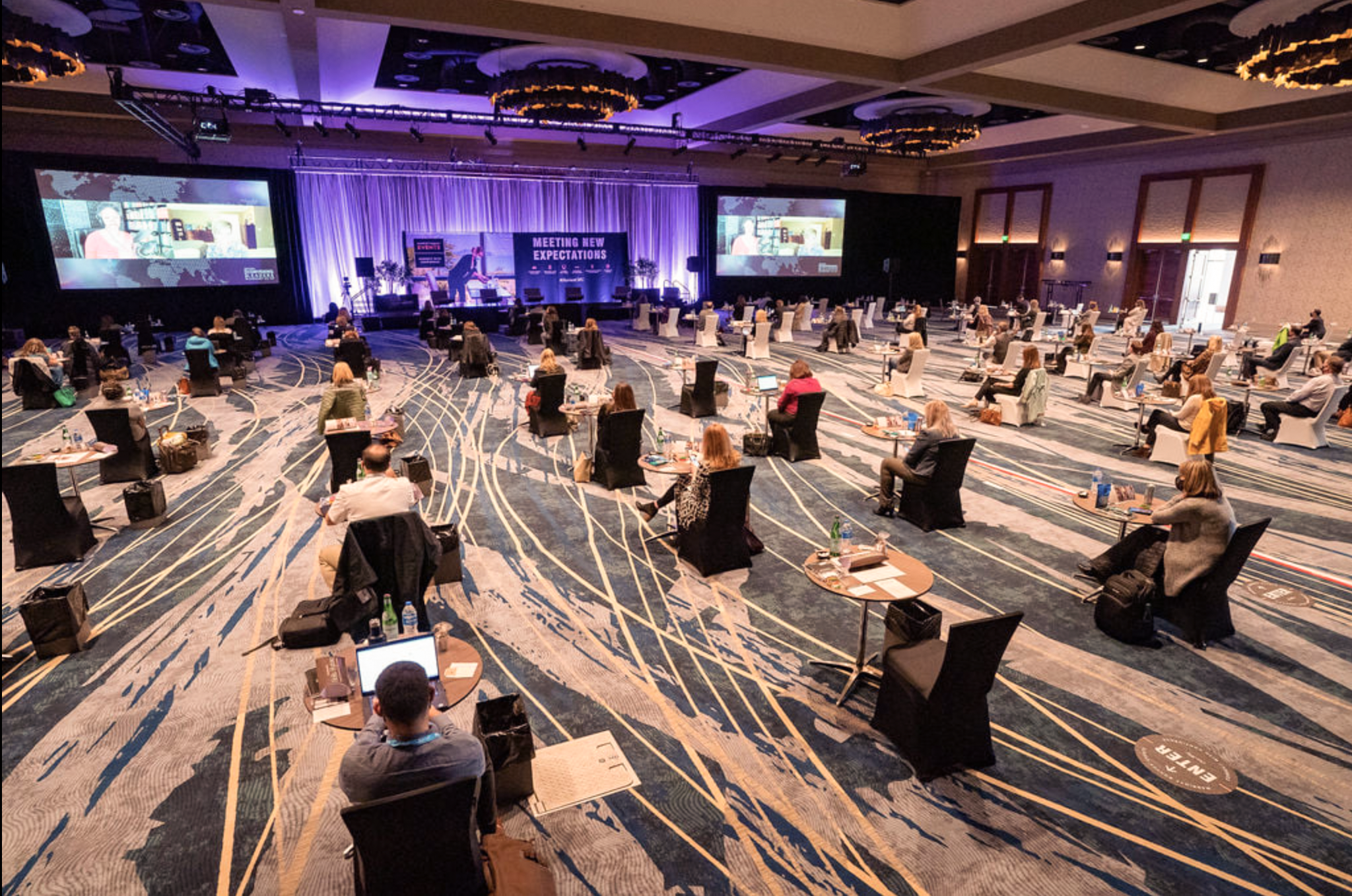Part 2 of our series on planning hybrid events. To read the rest of the series and our hybrid design case studies, click the links at the end of this article.
For sessions that will either happen in real time for both audiences or be broadcast at a later time for the virtual audience, presenters or panelists must adapt and rehearse their delivery to make sure they engage both audiences.
Michael Judeh, senior director of audiovisual technology for Convene, notes that “presenters with no studio audience lose the social cues they need to confirm they are connecting with participants. Imagine telling a joke in a vacuum and getting no response—the self-consciousness becomes overwhelming and the presenter will seem really disconnected. We need to get them feedback to guide them.”
Besides rehearsing in advance and using real-time polling or Q&A in a session, it also helps if speakers can observe an in-person audience while on stage, through technology if need be. Also, speakers should be able to see themselves on a downstage monitor to gauge their appearance and body language.
“There is definitely a higher level of speaker prep that planners have to conduct for hybrids,” adds Shayna Moskowitz, DES, director of meeting and event technology for Part 2 Events. For instance, “you have to make sure presenters look mostly into the camera rather than always looking across the in-person audience or at a downstage monitor. Instead, use a monitor that hangs above the main camera” in the same way late-night TV talk-show hosts do.
On the flip side, other things need to change if the presentation is coming from a remote location rather than the main studio. “That’s not an easy one to pull off,” Moskowitz says. “The presenter is probably being shown on the big screen at the in-person locations and can’t read those audiences at all.” In addition to offering some coaching during rehearsal for these speakers, planners should require audience polling at intervals to guide the speaker and maintain engagement.
One complication for hybrid meetings that can affect engagement: Signal latency, or the delay between a presenter who’s in studio or in a remote location and the attendees at viewing parties or at home. “Creating two-way seamless audio and visual connections to all attendee sites can be challenging,” says Judeh. “There’s a bit of lag that will require presenters and panelists to change their speaking cadence. Our bridge technology minimizes latency, but the more you have content originating from different locations, the more complexity you’re adding.”
Technological Considerations
Hybrid meetings require planners to partner with a virtual-event platform provider as well as a production company to make content presentation as professional as possible. Michael Doane, marketing manager for platform provider CadmiumCD, warns that “not all virtual-event providers have already pulled off a hybrid meeting. When sourcing, ask for examples of the hybrid events they have done so far.” Knowing which event-production companies a virtual-platform provider works with is also important. CadmiumCD partners with two sizable production houses, Projections and Falcon Events, to execute its hybrid events.
Interestingly, some hospitality brands are creating their own platforms in conjunction with their in-house production firms in order to provide planners with a one-stop shop for hybrid events. For instance, Hilton now offers the EventReady platform. The hotel company teams up with Encore (formerly PSAV) to provide a content studio set-up that includes staging, lighting, cameras, microphones, monitors, and other equipment and staffing necessary to broadcast content through EventReady.
High-tech venue manager Convene also has its own virtual-event platform but handles the production duties internally at its 29 facilities. According to James Frankis, a director of strategic solutions for Convene, the firm’s platform provides an event website so the host can market the event ahead of time with prerecorded content, then broadcasts the main-stage sessions and breakouts on the event’s dates, and then allows event participants or others to view those sessions after the live event. And the production team ensures that on-screen overlays are correct, presenters come in at the right moment, and video and audio is mixed and streamed correctly. There’s also in-ear technology that allows everyone behind the scenes in each location to communicate.
While hybrid-event content can come from places other than the hub location, Michael Judeh, senior director of audiovisual technology for Convene, suggests that organizers ask this question: Is the reward worth the additional complexity? “Every layer of technology and every physical site is a potential point of failure or delay, and cost,” he says. “Stability and reliability are king when it comes to content delivery. Find the path of least resistance to get that content out to everyone, and to craft the content in a way that engages all attendee segments.”
“It’s not just a question of the right platform; it’s also making sure the provider can give you the manpower and the experience to help you operate the system smoothly,” says Tom Reiser, executive director, International Society of Thrombosis. “Planners have no choice but to put a lot into their technology partner’s hands. Specifically for us, the attendee-interaction piece is critical—when we surveyed our members, they said they wanted to be able to talk to speakers during and after [virtual] sessions, and it’s so important we get that right technologically.”
HYBRID MEETING EDUCATION SERIES
HYBRID DESIGN CASE STUDIES

